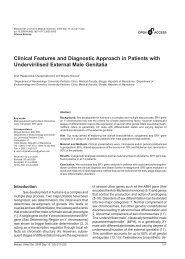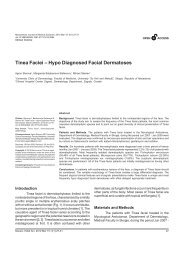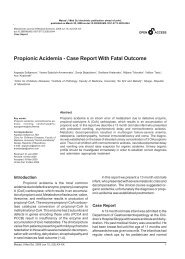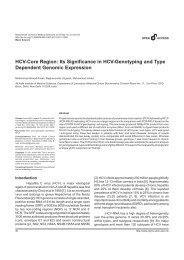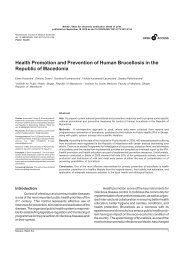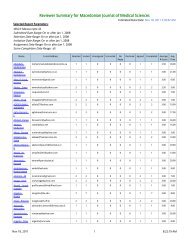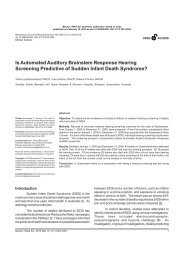Full text OnlineFirst (pdf) - Macedonian Journal of Medical Sciences
Full text OnlineFirst (pdf) - Macedonian Journal of Medical Sciences
Full text OnlineFirst (pdf) - Macedonian Journal of Medical Sciences
Create successful ePaper yourself
Turn your PDF publications into a flip-book with our unique Google optimized e-Paper software.
Clinical Science<br />
tackle the challenges <strong>of</strong> communicable diseases such<br />
as HIV/AIDS, Tuberculosis, Malaria and reduction in<br />
maternal mortality. Following the establishment <strong>of</strong> Nigeria<br />
cancer society in 1968, other non–governmental<br />
organizations like the breast cancer association <strong>of</strong> Nigeria<br />
(BRECAN), the bloom Cancer and Support Centre and<br />
Princess Nikky breast cancer foundation were formed to<br />
promote breast cancer awareness and <strong>of</strong>fer support to<br />
victims <strong>of</strong> the disease in the country. In addition, regular<br />
mass screening <strong>of</strong> women in their places <strong>of</strong> work,<br />
markets and worship centres employing clinical breast<br />
examination (CBE) was commenced by Lagos State<br />
government about a decade ago.<br />
We therefore prospectively studied the<br />
characteristics, presentation and quality <strong>of</strong> care <strong>of</strong> breast<br />
cancer patients seen at the out-patient clinic <strong>of</strong> a single<br />
general surgical unit <strong>of</strong> the Lagos State University<br />
Teaching Hospital (LASUTH), Ikeja-Lagos, Nigeria<br />
between January 2006 and December 2009. The<br />
objective is to assess the current state <strong>of</strong> breast cancer<br />
care and presentation in Lagos, a highly urbanized State<br />
in Nigeria. This may assist in defining the gaps in breast<br />
cancer detection and treatment in our community. It may<br />
also help in identifying areas where improvement are<br />
needed.<br />
Methods<br />
All patients with breast cancer presenting to one<br />
<strong>of</strong> LASUTH, General Surgical Clinics between January<br />
2006 and December 2009 were prospectively studied.<br />
Informed consent was obtained and the hospital<br />
Research and Ethics committee approved the conduct<br />
<strong>of</strong> the study. Information obtained included age, sex,<br />
marital status, occupation, level <strong>of</strong> education,<br />
reproductive and social histories <strong>of</strong> the patients.<br />
Presenting complaint(s), duration <strong>of</strong> symptoms, mode <strong>of</strong><br />
lump detection, history <strong>of</strong> past breast lesions and family<br />
history <strong>of</strong> breast disease were also documented.<br />
Tumours were clinically assessed and biopsies<br />
were taken for either histological or cytological diagnosis.<br />
Assessment <strong>of</strong> metastases was done by chest X-ray<br />
and abdominal ultrasonography and where indicated,<br />
skeletal X-ray and CT scan. Staging was done using the<br />
American Joint Committee on Cancer (AJCC) method<br />
[7]. Patients whose lesions were amenable to surgery<br />
were <strong>of</strong>fered simple mastectomy and level II axillary<br />
clearance after which they were all sent to the Oncology<br />
Unit for adjuvant chemotherapy and radiotherapy. Those<br />
with advanced diseases that were not suitable for<br />
2<br />
immediate surgical intervention were referred to the<br />
Oncologist after diagnosis for neo-adjuvant<br />
chemotherapy. Radiotherapy was recommended for<br />
patients with T4 lesions, N 2<br />
or N 3<br />
nodal stage, primary<br />
tumour <strong>of</strong> 5cm or more with positive axillary lymph node,<br />
axillary lymph node <strong>of</strong> >2.5 cm in diameter and Pectoralis<br />
muscle Fascia involvement. Patients were referred to<br />
another centre for radiotherapy because the facility was<br />
not available in our hospital. They were followed up at<br />
the oncology clinic and outcomes <strong>of</strong> treatment were<br />
documented. Data was analyzed using SPSS version<br />
15.0. Frequency tables were drawn; means and<br />
proportions were also calculated.<br />
Results<br />
Characteristics <strong>of</strong> Breast Cancer Patients<br />
A total <strong>of</strong> 350 new cases <strong>of</strong> primary breast<br />
cancer were seen during the study period. Age ranged<br />
from 23 to 104 years with a mean <strong>of</strong> 48.93 years (SD ±<br />
Table 1: Characteristics <strong>of</strong> breast cancer patients in LASUTH (n<br />
= 350).<br />
_________________________________________________<br />
No %<br />
_________________________________________________<br />
Age group (years) 20 – 29 10 2.9<br />
30 – 39 86 24.6<br />
40 – 49 98 28.0<br />
50 – 59 68 19.4<br />
60 – 69 62 17.7<br />
70 – 79 22 6.3<br />
> 80 4 1.1<br />
Sex distribution Females 344 98.3<br />
Males 6 1.7<br />
Marital status Married 326 93.0<br />
Single/widowed/divorced 24 7.0<br />
Level <strong>of</strong> education Illiterate 77 22.0<br />
Primary 90 26.0<br />
Secondary 88 25.0<br />
Tertiary 95 27.0<br />
Occupation Self-employed 266 76.0<br />
Civil/public servants 56 16.0<br />
Others 28 8.0<br />
Number <strong>of</strong> children None 14 4.0<br />
1 – 4 199 57.0<br />
> 4 137 39.0<br />
Menopausal status Pre-menopausal 224 64.0<br />
Post-menopausal 126 36.0<br />
__________________________________________________<br />
http://www.mjms.ukim.edu.mk



